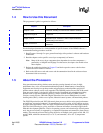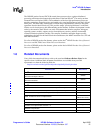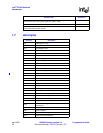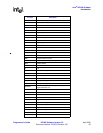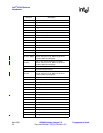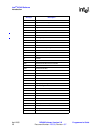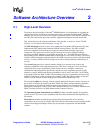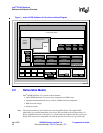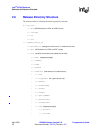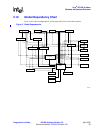
Intel
®
IXP400 Software
Programmer’s Guide IXP400 Software Version 2.0 April 2005
Document Number: 252539, Revision: 007 27
Software Architecture Overview 2
2.1 High-Level Overview
The primary design principles of the Intel
®
IXP400 Software v2.0 architecture are to enable the
supported processors’ hardware in a manner which allows maximum flexibility. Intel
®
IXP400
Software v2.0 consists of a collection of software components specific to the IXP4XX product line
and IXC1100 control plane processors and their supported development and reference boards.
This section discusses the software architecture of this product, as shown in “Intel® IXP400
Software v2.0 Architecture Block Diagram” on page 28
The NPE microcode consists of one or more loadable and executable NPE instruction files that
implement the NPE functionality behind the IXP400 software library. The NPEs are RISC
processors embedded in the main processor that are surrounded by multiple coprocessor
components. The coprocessors provide specific hardware services (for example, Ethernet
processing and MAC interfaces, cryptographic processing, etc.). The NPE instruction files are
incorporated into the IXP400 software library at build time (or at run-time for Linux). The library
includes a NPE downloader component that provides NPE code version selection and downloading
services. A variety of NPE microcode images are provided, enabling different combinations of
services.
The Access Layer provides a software interface which gives customer code access to the
underlying capabilities of the supported processors. This layer is made up of a set of software
components (access-layer components), which clients can use to configure, control and
communicate with the hardware. Specifically, most access-layer components provide an API
interface to specific NPE-hosted hardware capabilities, such as AAL 0 and AAL 5 on UTOPIA,
Cryptography, Ethernet, HSS, or DMA. The remaining access-layer components provide an API
interface to peripherals on the processors (for example, UART and USB) or features of the Intel
XScale core (for example, Product ID Registers or Performance Monitoring Unit).
The example Codelets are narrowly focused example applications that show how to use many of
the services or functions provided by the Intel XScale core library and the underlying hardware.
Many codelets are organized by hardware port type and typically exercise some Layer-2
functionality on that port, such as: AAL 5 PDU Transmit / Receive over UTOPIA, Channelized or
HDLC Transmit / Receive over HSS, Ethernet frame Transmit / Receive.
The Operating System Abstraction Layer (OSAL) defines a portable interface for operating
system services. The access-layer components and the codelets abstract their OS dependency to
this module.
Device Driver modules translate the generic Operating System specific device interface
commands to the Access Layer software APIs. Some device driver modules are provided by the OS
vendors’ Board Support Packages. Others may be provided in conjunction with the IXP400
software.




